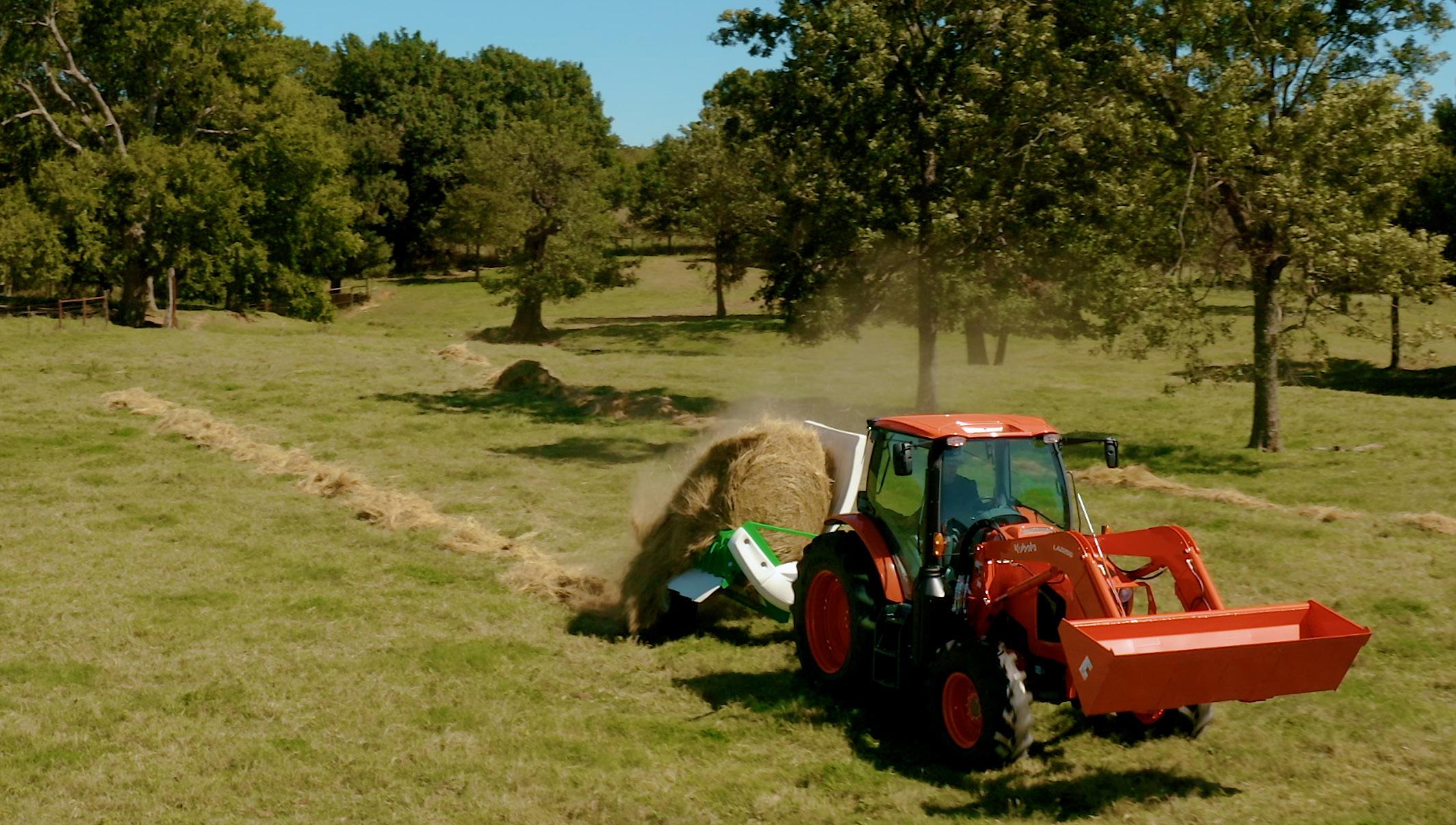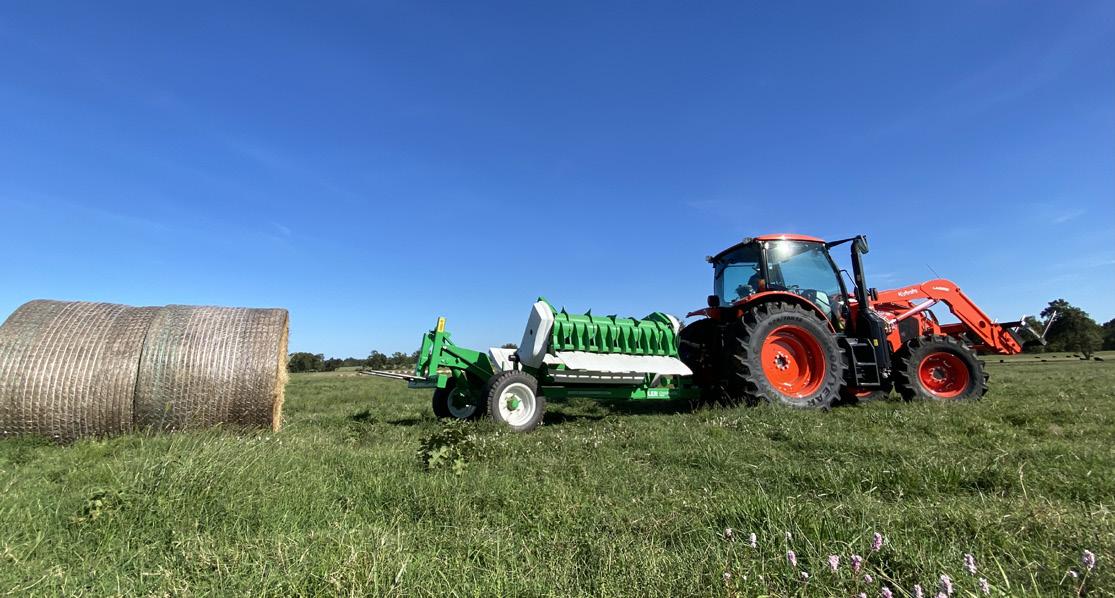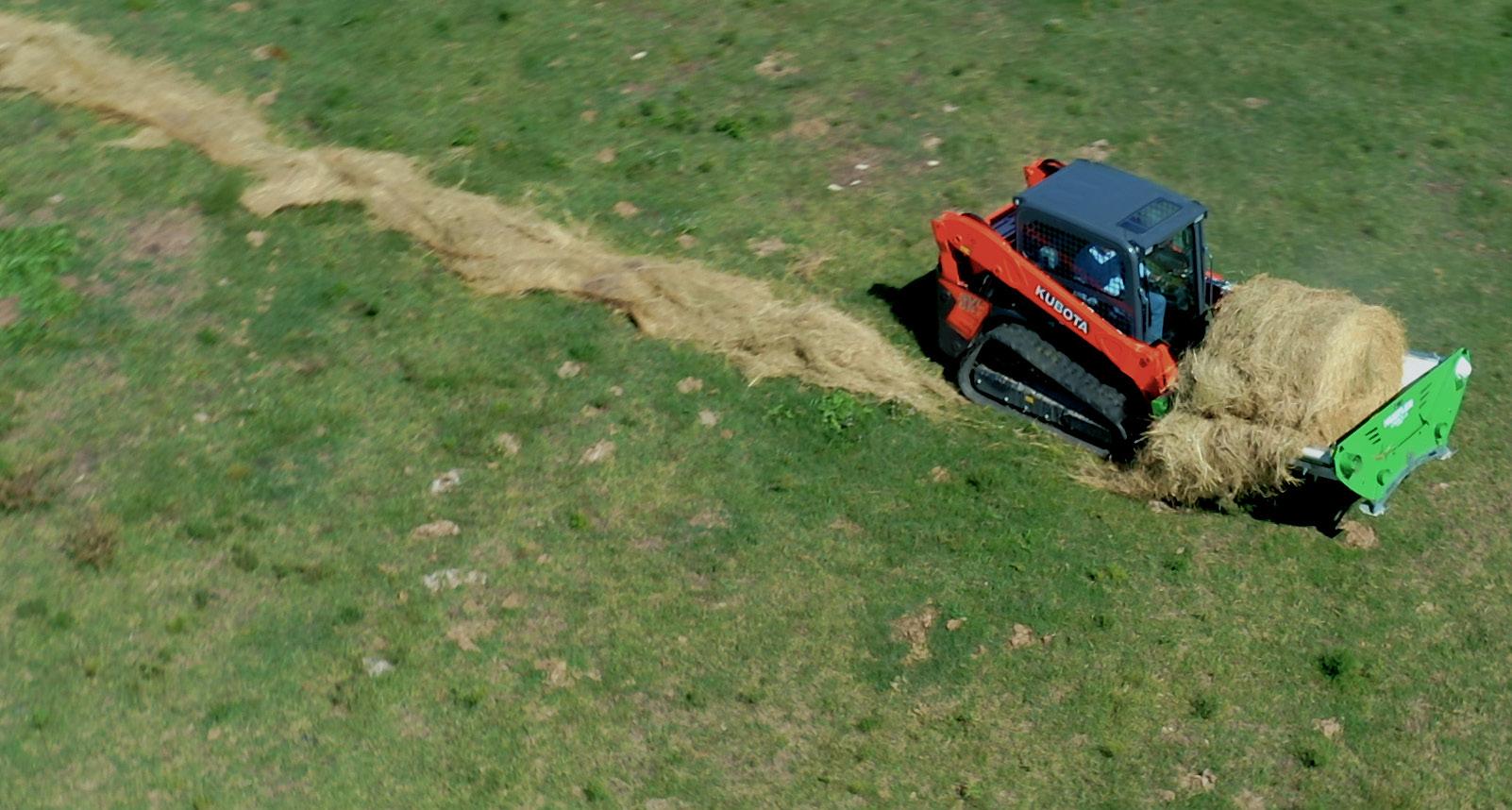
7 minute read
SUSTAINABLE HAY FEEDING

THE ART OF SUSTAINABLE HAY FEEDING IN A TOUGH ECONOMY
Hustler Mounted Chainless LX105™ bale processor Article by Lance Paskewitz
Livestock feed represents the largest single cost – often up to 60 percent of the total operation spending. Maybe now is the time to rethink your feeding methods.
The average bred cow weighs about 1,200 pounds and typically consumes 2.5% of her body weight on short stem hay, or 30 pounds/day of hay. Over an 80-cow herd, that is 2,400 pounds of forage fed daily or over 180 tons during a 5-month timeframe. At $55/ ton1, you will spend about $9,900 over that period.
According to a study by Dr. David Lalman of Oklahoma State University, “... the cows eating long stem consumed 1.8% of their bodyweight in dry matter (DM) intake and retained the same body condition.”2 So imagine if you could feed out long stem hay reliably with a bale processor, how much could you save?
Three essential factors can make a massive diff erence on your bottomline: hay wastage, forage quality, and the impact of your feeding method on pastures.
Drastically reduce your hay wastage Preserve the goodness of your hay
You already know that everything starts with the quality of your feed. Most operations put a lot of time, money, and eff ort into harvesting and storing the highest quality hay possible. Doesn’t it seem like you should carefully consider how you feed it out?
Most of the nutrition is retained in the leaves and/or grain; why create a bunch of dust and pulverize your hay by feeding with a traditional fl ailtype bale processor? To maximize nutritional uptake, it is essential to gently fl uff the hay out, so it’s not broken up and the nutrients destroyed and lost. The patented rotor system of the Hustler Chainless bale processors can help to achieve that result very easily in a limited amount of time.
Though minimizing wasted forage and being cost-eff ective is a key concern, it is far from the only worry. For most livestock ranchers, the main reason for allowing unlimited access





Wondering how many pounds of hay your cows are eating each day is maybe the wrong question. You should be asking how much hay your cows are wasting every day. Hay wastage depends on harvesting and storage techniques, but more importantly on the way its fed out.
Consider that more than 40% of your hay could be wasted3 because of losses associated with your feeding method. That’s like buying 100 bales of hay and then sticking a match to 40 of them! If we use the example we presented in the introduction, it means that in the best-case scenario, you are going to waste around 72 tons of forage this winter.
Maybe now is the time to think ahead and to re-evaluate the effi ciencies of your bale feeding system. One popular method is unrolling the bale on the ground in a thick matt. Another method, bale processing, is to chop the forage and feed out in large, thick windrows, resulting in huge losses because the hay is quickly blown away or trampled because too much hay is fed in one location. Alternatively, the Chainless bale processors, such as the mounted Chainless LX105™ bale processor or the trailed Chainless TX205™ bale processor from Hustler Equipment are designed to maximize every pound of DM thanks to their unique, gentle teasing action, pulling the hay apart in long stems, making the feed more palatable for stock and allowing you to feed out the exact amount in a long, thin windrow, drastically reducing nutritional loss and hay waste.



EXCAVATOR GRADE BUSHINGS
The loading system on the Chainless TH205 is uses hardened steel bushings the same as what’s used on excavators for ultimate durability and long life and slop-free operation.
PUCKBOARD PLATFORM
The reinforced steel platform is overlaid with 3/8” thick puckboard - the toughest poly material known to man. It maintains it’s slipperiness for ease of use, but at the same time can handle the impact of Hockey pucks at 105 mph while simultaneously enduring the coldest temperatures of the arctic!
REINFORCED PLATFORM FRAME
TH205 is built for durability from the ground up, with a double reinforced platform frame design you can be guaranteed of years of trouble free operation.
HYPAFLO WIPER
Designed to clean the rotors more effi ciently, the Hypafl o wiper panel minimizes blockages and ensures that hay drops outside the wheel tracks to avoid being fl attened into the mud. Panel can be easily released for easy cleaning.
OVERSIZED WHEELS
Massive fl otation, and cushioning the TH205 comes standard with larger diameter, wider 400/60R15.5 wheels in trac-grip pattern for extra traction, and a smoother ride.
Hustler Trailed Chainless TH205™ bale processor with optional Even Feed Roller attachment
OPTIONAL EVEN FEED ROLLER
Designed to accept our new Even Feed Roller for breaking apart highest density square bales into tighter windrows, and easier operation with round bales. It has a built in quick release system to switch between modes.
PATENTED AXIAL ROTOR
Patented axial rotor with centralizing paddles which keep the bale positioned in the center of the feeding chamber to minimize waste and provide better grip on soft center or rotary cut bales
OVERSIZED CHASSIS PLATES
The TH205 features beefed up chassis plates which reinforce pivot points to ensure it can handle the larger loads with ease.

to hay is the time and convenience. A study4 conducted by Dennis Hancock from the University of Georgia compared the time expended feeding dry hay to six groups of heifers. The result of this study shows that using a Chainless bale processor is by far the quickest way to feed out hay; even faster than a traditional hay unroller, a hay wagon, or even a hay ring.
Manage your pasture with your feeding routine
The benefi ts of using a bale processor are not all about hay savings. Robert Kallenbach from the University of Missouri5 found that for in 1.9 tons of high quality hay, your cows will return $86 in nutrients to the soil in the form of fertilizer. Based on the same fi gures we presented in introduction, it means that you could recycle up to $8,150 worth of fertilizer (manure) through cows fed on grass hay.
Old permanent pasture can be up to 25% less responsive and absorptive of nutrients in the soil, such as nitrogen, than newly renovated pastures. Regular reseeding would increase pasture productivity, but it’s a huge time and money investment. Ideally, feeding in a new part of the pasture every day in a long narrow windrow gives every animal equal access to feed and the hay bales drop their seeds into the ground in the process. Your whole pasture can be reseeded for (virtually) free and with no additional time spent while at the same time reducing compaction by keeping the animals spread out.
If you want to increase your pasture production and herd health along with reducing your hay wastage, you should rethink your feeding method immediately.
1 Prices can vary locally based on several different factors. 2 “Increased Feed Effi ciency and Nutritional Uptake of your Forages” by Dr. Lalman of Oklahoma State
University. 3 “Reducing Losses When Feeding Hay to Beef
Cattle” by Robert Kallenbach (PhD), Department of
Agronomy, University of Missouri. 4 “Minimizing the impact of hay feeding” by Dennis
Hancock (PhD),University of Georgia, Progressive
Forage. 5 “Accounting for Fertilizer Value in Purchased
Feeds for Beef Cows” by Robert Kallenbach (PhD),
Department of Agronomy, University of Missouri.
With a wide range of mounted and pull-type bale processors, Hustler has been a game-changer for many livestock operations across the United States and Canada. Versatility is the key – the Hustler bale processor range can be adapted on most brands of tractors, payloaders or skid-steers. Visit the American Cattlemen Facebook page at facebook.com/americancattlemen to watch Hustler ranchers’ reviews. Need to see it with your own eyes? Book a free demo now at hustlerequipment.com/us.
HUSTLER’S PULL-TYPE BALE PROCESSORS ARE SELF-LOADING AND CARRY TWO BALES
01 Back tines into bale 02 Bale is always under control
Unroll the Options: Hustler Equipment offers various unroller options to meet the equipment needs for any operation. Photos By: Adam Carter & Reed Boettcher
03 Remove net wrap










